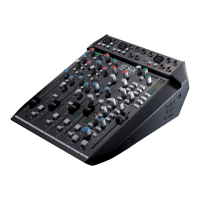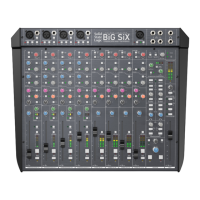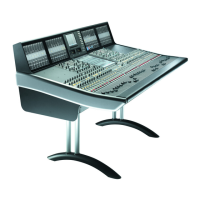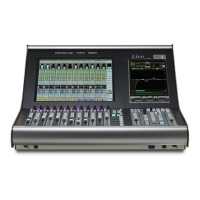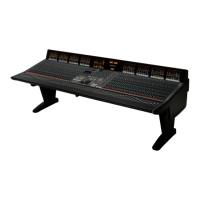REC and MIX Busses
1
In addition to the CHOP, the channel’s main fader can feed the record and/or mix bus.
These are selected using the
REC and MIX bus buttons at the bottom of the Master
Channel which light up to indicate the presence of routing. This routing is also indicated
by the lighting of the
REC and MIX symbols at the bottom of the meter section above
the channel (shown left). You will notice that throughout the desk, references to the
REC bus are red, references to the MIX bus are yellow, and references to the MON
bus are green.
The signal level being sent to the record and mix busses is controlled by the fader at the bottom of the channel. The channel’s
feed to the record and mix busses is panned using the pan pot towards the bottom of the routing section of the channel strip
(shown below), which includes a Total Recall LED. The pot is indented in the middle, where the signal is feeding both the left
and right busses equally.
DAW Monitor Mode
When INPUT has been selected as the channel source, pressing the
DAW MONITOR button in the Master Channel (shown right) enables the TRK button,
recording following the classic in-line style of previous generation SSL consoles. The
signal received from the input is routed through any processing applied via the Insert
Matrix and then to the DAW via the channel output.
With
DAW MONITOR mode active, pressing TRK switches the monitoring source for that channel between
the CHANNEL OUT (post-gain) output (the DAW send) and the DAW RTN input (pre-gain).
Both the Master Channel’s
DAW MONITOR button and the channel strip’s TRK button light up to indicate that DAW Monitor
mode is active. The colour of the
TRK button also indicates which monitoring source is selected: green for DAW return and
yellow for channel out.
When the
DAW MONITOR mode is active, full zero latency drop in and Record monitoring is available via the AUTO MON
button above it.
AUTO MON allows the desk to take control of the TRK buttons, automatically switching the monitoring
source on any channels in
DAW MONITOR mode depending on the status of the DAW transport and track record tally:
- When the transport is idle the monitoring source for these channels will be the channel output.
- When the transport is in Play the monitoring source will be the DAW return.
channel output.
DAW MONITOR
DAW MONITORINPUTCHOP
Cut and Solo
Above the fader, there is a CUT switch which immediately mutes the channel’s output, and a SOLO button
which mutes all other channels, leaving that channel as the only signal reaching the monitors.
and
Chapter 3 - Analogue Signal Flow
34
Matrix
2
Owner’s Manual
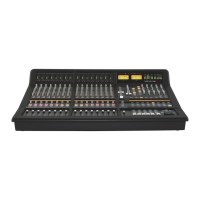
